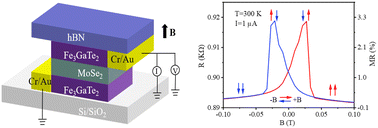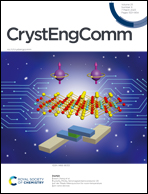Fe3GaTe2/MoSe2 ferromagnet/semiconductor 2D van der Waals heterojunction for room-temperature spin-valve devices†
Abstract
A spin-valve heterojunction plays a vital role in many technologies such as non-volatile magnetic random-access memories (MRAMs) and high-density magnetic recording. In particular, a spin-valve device based on two-dimensional van der Waals (vdW) heterostructures offers an excellent route for low power consumption and miniaturization of spintronic devices. However, the Curie temperature (TC) of 2D vdW ferromagnetic crystals is mostly lower than room temperature, and the spin-valve heterostructures of room-temperature ferromagnetic 2D crystals are rare. It is necessary and very challenging to realize the room-temperature spin-valve heterojunctions of 2D ferromagnetic crystals. We prepare a 2D room-temperature, ferromagnetic crystal based 2D vdW Fe3GaTe2/MoSe2/Fe3GaTe2 ferromagnet/semiconductor 2D van der Waals heterojunction. The magnetoresistance (MR) of this heterojunction device reaches 3.7% at room temperature (T = 300 K) and 37.7% at 2 K. Importantly the spin-valve effect can still operate at bias currents as low as 10 nA at room temperature in the ferromagnet/semiconductor 2D van der Waals heterojunction. We open a realistic path to 2D magnetic tunnel junctions for next generation spintronic applications at room temperature.

- This article is part of the themed collection: Editor’s Collection: Advances in nanocrystal heterojunctions


 Please wait while we load your content...
Please wait while we load your content...